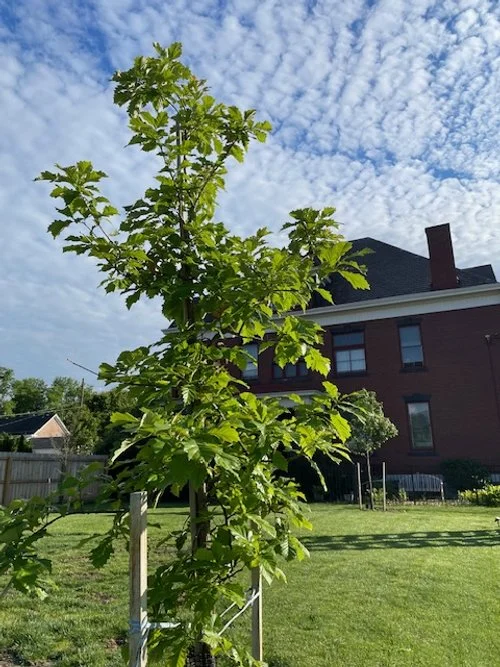
Swamp White Oak
The swamp white oak (Quercus bicolor) is a hardy, long-lived deciduous tree native to the central and eastern United States, particularly thriving in low-lying, wet bottomlands, floodplains, and swamps—hence its name.
Known for its adaptability to both wet and upland soils, this oak species can grow up to 60–80 feet tall, featuring distinctive leaves with shallow lobes that are dark green above and whitish underneath. In autumn, its foliage turns a mix of yellow and bronze, adding seasonal beauty to the landscape. The swamp white oak produces acorns that serve as a vital food source for wildlife, including deer, squirrels, and birds.
Due to its tolerance of urban conditions, it is also a popular choice for parks and streetscapes, valued for its stately form and ecological benefits.

Red Maple
The red maple (Acer rubrum) is one of the most widespread and adaptable deciduous trees in eastern North America, known for its brilliant red foliage in autumn, as well as its red flowers, stems, and seeds in early spring. Growing 40 to 70 feet tall, it thrives in a wide range of soil types and moisture conditions, from dry uplands to moist bottomlands. The red maple’s fast growth, attractive shape, and vibrant seasonal color make it a popular choice for urban planting and landscaping. Its flowers provide early nectar for bees, and its seeds (samaras) are a food source for birds and small mammals. With its combination of beauty, resilience, and ecological value, the red maple is a defining feature of many American forests and communities.

Hophornbeam
The hophornbeam (Ostrya virginiana), also known as ironwood, is a small to medium-sized deciduous tree native to eastern North America. It typically grows 25 to 40 feet tall and is valued for its dense, durable wood and attractive, birch-like appearance, with finely serrated, oval leaves that turn yellow in the fall. The tree gets its common name from its fruit, which resembles clusters of hops used in brewing beer. Hophornbeam is highly shade-tolerant and thrives in well-drained soils, making it a common understory tree in hardwood forests. Its extremely hard wood was traditionally used for tool handles and fence posts, and its resilience and adaptability make it an excellent choice for naturalized landscapes and conservation plantings.

Serviceberry
The serviceberry (Amelanchier spp.) is a small, ornamental deciduous tree or large shrub native to North America, admired for its multi-season beauty and ecological benefits. In early spring, it produces delicate, white, star-shaped flowers that often bloom before the leaves emerge, followed by small, sweet, blueberry-like fruits in summer that are prized by birds and edible for humans. Growing 15 to 25 feet tall, serviceberries have smooth gray bark, oval green leaves that turn brilliant shades of orange and red in fall, and an elegant, branching form. They thrive in a variety of soil types and light conditions, making them versatile for gardens, parks, and naturalized areas. With its combination of beauty, wildlife value, and cultural significance, the serviceberry is a beloved native tree across much of the continent.

Eastern Redbud
The eastern redbud (Cercis canadensis) is a small, graceful deciduous tree native to eastern North America, celebrated for its vibrant early-spring display of pink to magenta flowers that bloom in clusters directly on branches and trunks—a phenomenon known as cauliflory.
Typically reaching 20–30 feet in height, it has a rounded crown and heart-shaped leaves that emerge reddish, turn green in summer, and often take on yellow tones in fall. The redbud thrives in a variety of soils and light conditions, making it a popular ornamental tree in both gardens and natural landscapes.
Its blossoms are a crucial early nectar source for pollinators, and its distinctive beauty makes it a beloved symbol of spring across much of the United States.
(something about the redbud project here)





